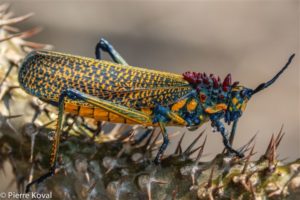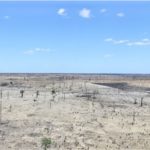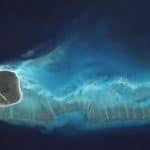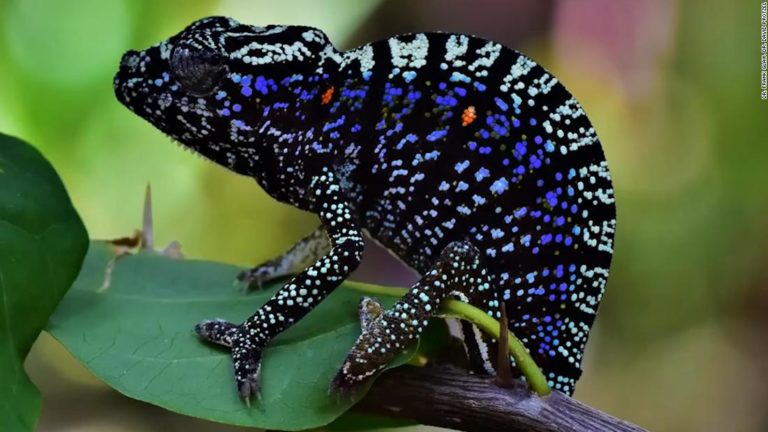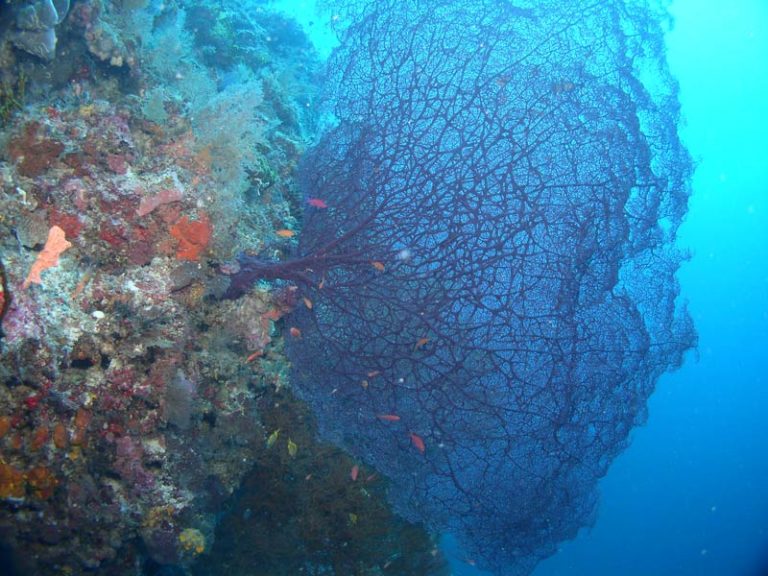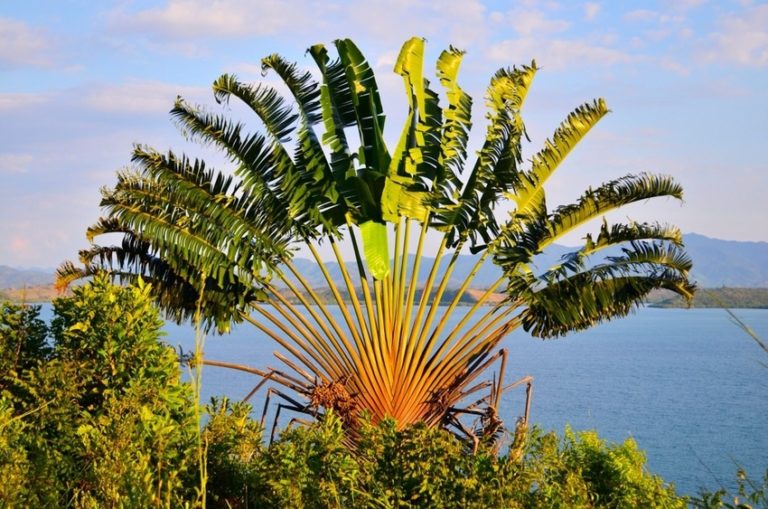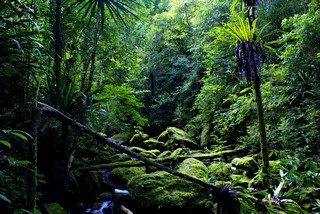Invertebrates from Madagascar
Invertebrates make up about 95% of all animal species on Earth. Since the separation from Gondwana, an incredible number of invertebrates have evolved in Madagascar.
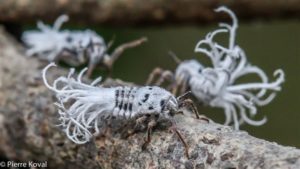 Today, no one really knows their number, but it is estimated that there are more than 100,000.
Today, no one really knows their number, but it is estimated that there are more than 100,000.
So this small section offers just a glimpse of the bizarre and wonderful shapes found in Madagascar.
An observer will encounter many of these animals in the Malagasy forests.
It is always useful to look under rotten stones and logs (still watching for scorpions and scolopanders), carefully looking in the leaves and on the logs, especially to look for mimetic insects.
The phasmas (stick insects) of Madagascar
Phasmas can be confused with small branches and mosses and are therefore very difficult to recognize.
The Stick insects Madagascar are very little known because they have been neglected for almost a century.
General overview of the diversity of the stick insects of Madagascar.
With probably less than a quarter of the native species described, the Stick insects very little known in Madagascar.
The Phasmas of Madagascar are therefore still among the least known insects. Ninety species have been cited from the island, but due to errors in geographic distribution and established synonyms, the number of known species is actually closer to seventy.
However, this does not reflect the richness of the Malagasy fauna reflected, for which I know more unpublished than described species, and for which I estimate the total number of species at probably nearly three hundred: The general collection of the entomological laboratory of the Paris Museum contains dozens of unpublished species, and each field mission reveals its share of novelties.
In addition, many regions have never been explored for this insect species.
Variety of the Stick insects in Madagascar
The Stick insects in Madagascar are divided into four groups: Achriopterini, Anisacanthididae, Antongiliinae and Damasippoidididae.
The Antongiliinae and Damasippoididae are exclusively endemic to the Big Island, while the Achriopterini and Anisacanthidae are endemic to Madagascar and the Comoros.
The blue stick insects
The Blue phasma (Achrioptera fallax) is native to Madagascar. It differs from the other phasmas by its large size (26 cm for females) and the metallic blue color of the males.

Madagascar is known as a biodiversity hotspot.
The fauna of the phasmas of the Big Island is an excellent example of this fact: while this fauna is still little known with less than 75 described species, preliminary studies have allowed scientists to count nearly 120 species.
While many specimens are still in museum collections waiting to be explored.
Proof that the inventory of Malagasy forests is far from complete.
These facts suggest the existence of at least 400 Malagasy species.
Madagascar is also home to three naturalized, or introduced, species.
Centipedes and scolopenders
Centipede and Iule (Archispirostreptus gigas)
Archispirostreptus gigas is an arthropod from the class of diplopods (millipedes). The giant African Iule, so named, is the longest of the diplopods: The largest recorded individuals measure 38.5 cm in length and 2.1 cm in diameter; they have 256 legs.
In the tropical-humid parts of Madagascar they are widespread, rarely above 1,000 meters.
These arthropods are completely harmless and they live mainly in forests, but also in coastal areas if they have at least a few trees.
Archispirostreptus gigas is black in color, but there are also beautifully orange & black striped specimens and another species that are green.
The red-legged fire centipede (Aphistogoniulus-corallipes)
This giant centipede, endemic to Madagascar, is threatened with extinction. Today it lives only in a fragment of forest of 10 km², which is under severe pressure from slash-and-burn and deforestation.
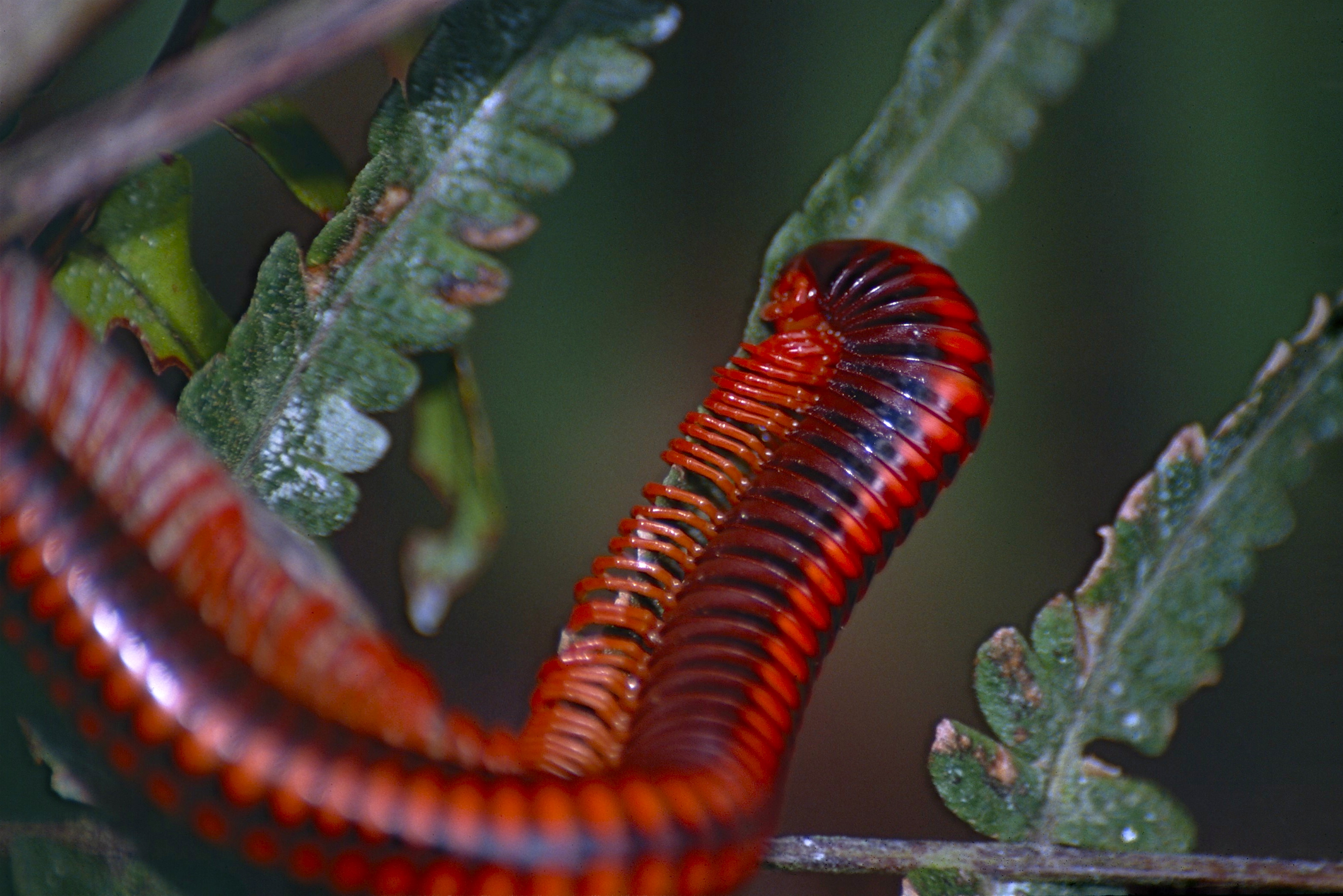
Its body is long, measuring between 9.8 and 13 cm in adult individuals and between 8 and 10 mm in width.
It consists of 48 to 50 rings - otherwise rings with feet - which are combined in pairs: This is called a diplopod. The red-legged fire centipede therefore belongs to the diplopods, not to the chilopods, the other group of centipedes.
Zoosphaerium neptunus
Zoosphaerium neptunus is the largest millipede pill in the world, measuring 90 mm (3.5 in) long. They are endemic to Madagascar and are known to swarm at certain times of the year.
Zoosphaerium neptunus is an impressive Malagasy myriapod that feeds on algae, mosses and lichens in the wild and dead leaves and dead wood as well as various plants in captivity.

From Madagascar the first records of mass occurrence (swarming behavior) in giant pill - millipedes, are reported.
The swarming behavior in the Order Sphaerotheriida appears to be restricted to a single of more than sixty described Malagasy species, Zoosphaerium neptunus , which is the world's largest known giant millipede.
Coiled individuals can reach the size of a baseball, tennis ball, or small orange, but only females reach this giant size, with males smaller than a ping pong ball.
The single swarm is restricted to specimens of a single related size (and presumably age) class; often only sexually mature individuals; swarming behavior is obligate, with most if not all specimens of the species in a given area participating in such swarms; Z. neptunus specimens are rarely, if ever, not found in a swarm.
The reasons for such mass events in millipedes are currently poorly understood, but one possible explanation for mass occurrences in Z. neptunus could be a higher survival rate due to predation combined with a close sibling relationship between members of a swarm.
The almost obligate swarming behavior of the widespread Z. neptunus species may pose a conservation problem, as entire swarms, and thus an entire generation, may be lost in a given area due to anthropogenic interventions such as excessive collecting for the pet trade, habitat fragmentation, or vehicles.
Skolopender
In the eastern rainforests we can mention the presence of centipedes, which are very colorful (yellow, red), a characteristic that indicates that these invertebrates are poisonous to potential predators.
Where can you find them in Madagascar?
Scolopendria generally live in areas that tend to be humid and where the climate is particularly hot, i.e., they 
So you will meet them in the woods, in the high grass, but also under the stones or in the cracks of the walls and occasionally in the houses.
Scorpions
Scorpions are among the few animals that are dangerous to humans.
They are active mainly at night, while during the day they remain hidden under stones and in crevices in the ground. The most common species belong to the genus Grosphus.
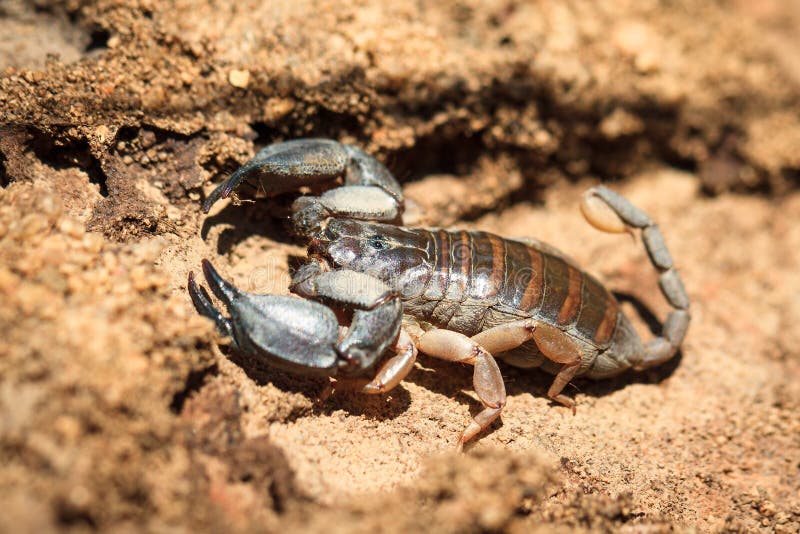
Scorpions from Madagascar are all endemic. They are found in various biotopes and are distributed over the entire surface of the island. In Madagascar, the species encountered are generally not lethal. Paradoxically, the most dangerous species do not give the most painful stings.
Scorpions have two large pincer-shaped pedipalps and a long, segmented abdomen that ends in a venomous sting that is sometimes used to kill prey, but mostly for self-defense.
They seek shelter in rock crevices or caves during the day and hunt at night at a length of 6 mm to 20 cm on the species Scorpio viatoris, which is widespread in Africa. They are animals that easily adapt to their environment and can withstand extremely high temperatures.
The scorpion is active at night. The rest of the time it remains hidden under stones or in rock crevices. It stings only when it is threatened.
Opisthacanthus madagascariensis
A new species is described, Opisthacanthus titanus sp. n., known from Torotorofotsy forest in eastern Madagascar.

The new species and O. madagascariensis have similar external morphology, but their morphometric values are significantly different. In addition, O. madagascariensis occurs exclusively in thorny thickets and open tree formations, whereas the new species originates from the Torotorofotsy rainforest.
The total number of species in Madagascar has now risen to twelve.
Moths & Butterflies from Madagascar
There are about 4000 species of moths and 300 diurnal species in Madagascar. Butterflies began to emerge long before the 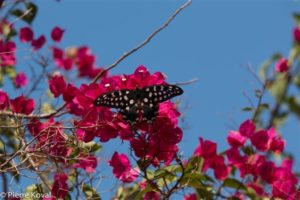
Butterflies are very numerous as soon as you get away from the cities. Day and night they appear in a wide variety of shapes and colors.
Butterflies from Madagascar- More than three thousand species
More than three thousand species of butterflies, most of them endemic, have been observed in Madagascar. Their preferred habitat is the humid forests bordering the east coast of the Big Island.
These wonders of nature with magnificent colors and surprising shapes have funny names like Comet, Swallow, Cape Diego, Urania.
Chrysiridia rhipheus
Chrysiridia rhipheus is a species of diurnal lepidopteran in the family Uraniidae and the genus Chrysiridia, one of the three genera of butterflies in the Uraniidae.
The imago of this species is sometimes considered one of the most beautiful butterflies in the world.
Its span varies between 70 and 90 mm and can exceptionally reach 110 mm.
The upper side of the forewings has a black ground color with golden markings, while the hindwings have a sch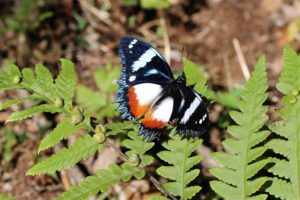
The underside of the forewings is light blue with black markings, while the hindwings have a small golden-green base and a broad band of gold, then iridescent red and pink in the anal region. The tails are light blue and white.
These colors depend on the polarization of the light.
It is not subject to diapause, but populations are more numerous from March to August.
The caterpillar stage lasts 2 to 3 months, depending on the season.
It is a walk between the forests in the west and east of the island.
The comet butterfly or Argema mittrei
The comet butterfly or Argema mittrei is probably the largest butterfly in the world.
This impressive Lepidoptera has a yellow color and reddish-brown globules on each of its wings. The male, larger than the female, can measure up to thirty centimeters.
The Madagascar Comet butterfly, also called Argema mittrei, is a butterfly of the Saturniidae family. It is one of the endemic species of Madagascar.
It originates from the rainforests of Madagascar and is one of the largest butterflies in the world. In fact, it can be compared to 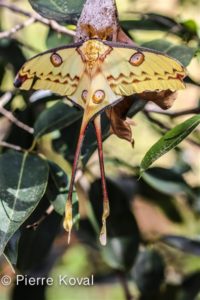
The larvae spend 2 months of their life in the caterpillar stage. They feed on fresh eucalyptus, liquidambar and mimosa leaves before enclosing themselves in a cocoon to undergo its final metamorphosis.
It takes no less than two to six months to achieve the aesthetic perfection that characterizes their species.
The adult life of the comet butterfly of Madagascar lasts only 4 or 5 days, which are devoted to reproduction. It does not feed because its proboscis is atrophied.
The Madagascar Comet butterfly is a moth, but if you are lucky you can see it in the early morning.
All these wonderful animals are now threatened with extinction because their collection for commercial purposes is excessive and their territory shrinks every year like a skin of sorrow due to deforestation.
Leech
When walking in the rainforests, it is possible (not to say common) to be disturbed by leeches.
They are small and do not live directly in the water, but take advantage of the very high humidity by attaching themselves to the leaves of the trees. There they wait for a warm-blooded victim.
Even if their bite seems unpleasant it is completely painless, there is no danger to humans.
To protect yourself, you must wear boots or shoes that are well closed. Once a leech has eaten, it can grow to four times its normal size. In the Mangroves it is customary to observe.
Especially the Ranomafana National Park is affected by this, but in all Rainforests one can assume to be affected by it.
Madagascar spiders
The last development of Malagasy arachnological knowledge dates back to about seventy years ago. 1948 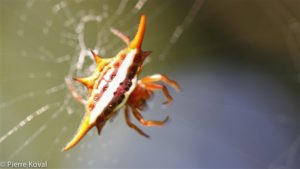
Today our conclusions will be the same, even though in the last two decades numerous surveys and systematic hunting have greatly expanded our documentation of arachnids. Important collections are currently being studied and it will be necessary to wait for the publication of their results before commenting on the value of the studied groups.
Pelican spiders - cannibals without webs!
Pelican spiders (Eriauchenius milajaneae) do not weave webs; they owe their name to the pelican bird because of their unusually long neck and long claws called chelicerae, which resemble beaks.

And as prey, this arachnid hunts only its own kind, because the pelican spider is a cannibal.
These newly identified spiders are true living fossils.
In fact, their ancestors were found in fossils that are 165 million years old, and scientists had assumed that these species were extinct. Thus, these living spiders now belong to the "Lazarus", a species so named because they have returned from the dead.
Golden Nephilidae (Trichonephila inaurata)
Like all spiders of this family, the golden nephile has a very elongated shape and very long legs. These are orange or red, and its abdomen (or opisthosoma) is golden or black. It is a passive and harmless spider, but its bite can be painful.

The net of the golden Nephile is always tilted about 15° from the vertical, so that the prey always hangs on this net and cannot free itself from it. The golden nephile makes its net vibrate with its legs when a movement of the net is felt. This seems to be a way to accurately locate the captured insect.
The male lives in the web of the female, usually on the opposite side. He feeds on his prey.
Spider silk-a precious and exquisite natural product
25,000 spiders are needed to produce 30 grams of spider silk.
The golden nephi is an impressive spider, it measures up to 20 cm and its body is yellow and black.

Its resistance is so great that the net of the golden Nephile can stop a bird in its flight.
This project for weaving spider silk from Madagascar was carried out in 2012. It is the result of collaboration between British Simon Peers, American Nicholas Goodley, excellent Malagasy technicians and a million spiders!
The spiders provided their threads for five years to make this 4 meter long golden silk. The threads are extracted from 24 spiders at a time with a manual machine. Thus, 70 people were recruited to capture the little beasts and release them into their natural environment once the threads were recovered. On average, between 23,000 and 25,000 spiders are needed to produce 30 grams of silk.
Spider silk technique inspired by the Landy tradition
In the 1880s, the Jesuit missionary Paul Camboué, a member of the Malagasy Academy and a passionate arachnologist, constructed a machine in Antananarivo to harvest the threads of the golden nephilis. At that time, there was a workshop and a school in Madagascar that trained in silk techniques, inspired by traditional weaving techniques. Unfortunately, this project proved to be very expensive and the industrial use of these spiders led to the spread of mosquitoes, vectors of malaria.
In 1898, Mr. Noguè, who was one of the directors of the Professional Weaving School, had a new extractor for spider silk made.
Thus, tests were carried out in Lyon thanks to the spider eggs sent by the Galieni, but the spider did not withstand the climate and the journey and all perished, so the project remained there.
The last pieces made of spider silk date from the end of the 19th century and were created for the 1900 World's Fair in Paris: It was a set of blankets for a four-poster bed, made entirely of spider silk from Madagascar. Today, unfortunately, this piece has disappeared.
In 2011 and 2012, Peers and Goodley's gold spider silk cape was exhibited at the Victoria and Albert Museum in London and the Art Institute of Chicago.
The newly discovered Darwin spider (Caerostris Darwini)
The Malagasy spider Caerostris Darwini, discovered last year in Andasibe-Mantadia National Park, ranks first among the world's most spectacular new species, according to a ranking compiled by the International Institute for the Study of Species.

Its gigantic traps can catch several dozen insects, enough to feed its small body, which is no more than two centimeters long. The spider Caerostris Darwini has an average length of 6 mm for males and 2 cm for females.
The Malagasy spider was discovered in 2010 by a team of scientists from the University of Puerto Rico in the Andasibe-Mantadia National Park and is the most surprising spider in the world, according to a classification by the International Institute for Species Research.
Very many other species of spiders can be observed in Madagascar, to name a few: Acrosomoides acrosomoides, the tiny jumping spider, crab spiders, green lynx spider and many more.
The best observations can be made in Ranomafana and in Andasibe.
Madagascar beetle
Among the Beetles of Madagascar there are also some eccentricities of nature to consider.
The Giraffe beetle (Trachelophorus giraffa) is a long-necked beetle belonging to the family Attelabidae. The neck of the males is larger than that of the females, up to almost three times the size of the females. It is a species endemic to Madagascar.
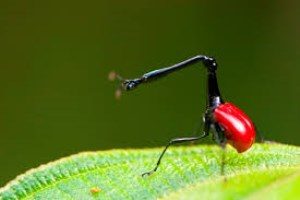
The giraffe beetle is a few centimeters long (15-25 mm for a male, 12-55 mm for a female) with the peculiarity of having a particularly long neck with a single hinge, which gave it its name.
This disproportionate neck is used to fight for a female during real tournaments.
The giraffe beetle feeds on melastome leaves, more specifically on Dichaetanthera cordifolia and Dichaetanthera arborea.
The same leaves are used by the female when she builds a nest for her egg (see Protection of the young).
The giraffe beetle is exclusively herbivorous and will not attack any other animal and surprisingly, they do not appear to have any enemies of their own.
The female builds a nest with the half-cut leaf of a small tree (Dichaetanthera cordifolia), which she wraps around herself with her strong legs.
By cutting into the sheet lengthwise at strategic points and adding small indentations to the edges, she creates a kind of "zipper" that holds the building in place and makes the folding job easier.
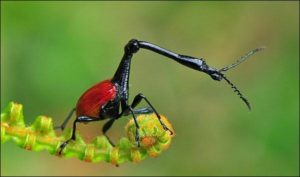
While busy, the male remains nearby to exclude other potential competitors and to chase away small parasitic arthropods that might enter the nest.
Once the nest is completed, the female lays a single egg in it before finally closing the nest and cutting off the stem of the leaf used so that the work falls to the ground, where the larva develops into an adult.
Each of the nests created by each of the females appears to have its own unique appearance.
It is suspected that small insects devour the eggs in their nest on the ground and cause the male to guard his offspring for as long as necessary, but this has not yet been proven.

